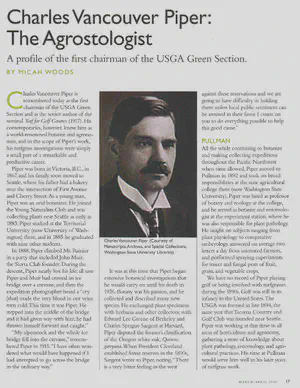“Nothing mysteriously beneficial in their formulas”

The Turfgrass Talk Show at GIS had an interesting topic. Interesting, in that I presume by fertility what is really meant is turfgrass nutrition. And interesting, in how the word fertility is so misused.
Look up fertility in the dictionary: it means the quality of being fertile; fruitfulness; productiveness. Fertility is. It is not something one adds or subtracts. That is fertilizer. One can’t add a little more fertility, or reduce fertility—that just doesn’t make sense.
Charles Vancouver Piper, the first chairman of the USGA Green Section, wrote about this in 1919, in The Words Productivity, or Productiveness, and Fertility as Applied to Agriculture. Here are a few passages from the article:
The word fertility was originally used by the Romans when applied to agriculture with the meaning of fruitfulness, that is, productiveness in large measure.
The word fertility in modern times has tended to become more and more restricted to the conception of soil fertility, thus excluding the other potent factors that make for productivity.
In view of the fact that the word fertility is often used in agriculture in the narrow sense of soil fertility, as well as in its broader original meaning, it is an unsatisfactory and often ambiguous term to use in technical publications.
As before stated, the word fertile means productive in a high degree. Therefore, it approaches the absurd to speak of low fertility, moderate fertility, etc.
Piper suggested not using the word. James Hempfling asked if Piper had discussed this topic in Turf for Golf Courses. Note that this book is one of many with full text available from the Turfgrass Information Center.

I went to the Fertilizers chapter of the book, to see how Piper and Oakley had used the word fertility. Turf for Golf Courses was published two years before the fertility terminology article. They used the word just five times in the entire book, and only one time in the Fertilizers chapter. And in all cases, they used the word to refer to soil fertility, specifically to the nutrient supplying capacity of the soil.
But enough about that. What was really interesting was this advice about fertilizers:
It is a common practice of commercial fertilizer companies to mix fertilizing materials in different proportions with the view to selling them for special conditions. These ready-mixed fertilizers are extensively advertised under various trade names such as “Turf Grower,” “Grass Grower,” “Lawn Fertilizer,” and the like, and the opinion seems to prevail in the minds of many that they are just what is required. While these mixed fertilizers are very generally used, they are not to be recommended. Commercial concerns possess no special information regarding the action of fertilizers on grass that an intelligent greenkeeper cannot soon acquire, and, therefore, there is nothing mysteriously beneficial in their formulas.
When mixed fertilizers are desired, it will be found cheaper and generally more satisfactory to buy the ingredients separately and combine them in suitable proportions. By doing so the purchaser does not have to pay a high price for a considerable quantity of inert filler that is commonly present in ready-mixed fertilizers.
For more about the exciting life of C.V. Piper, this profile tells how he climbed Mt. Rainier with John Muir, collected plants and grasses around the world, and what happens to one’s golf game after becoming interested in golf course design, construction, and maintenance.
